At the kitchen end of the hall hang five portraits, including our founding benefactors – Julia Warde Aldam and Douglas Horsfall – and three Principals, Stephen Moulsdale, John Brewis and John Fenton. You can learn more about each of them here to see how they contributed to the founding and history of St Chad’s.
You can read about the History of St Chad’s College here.
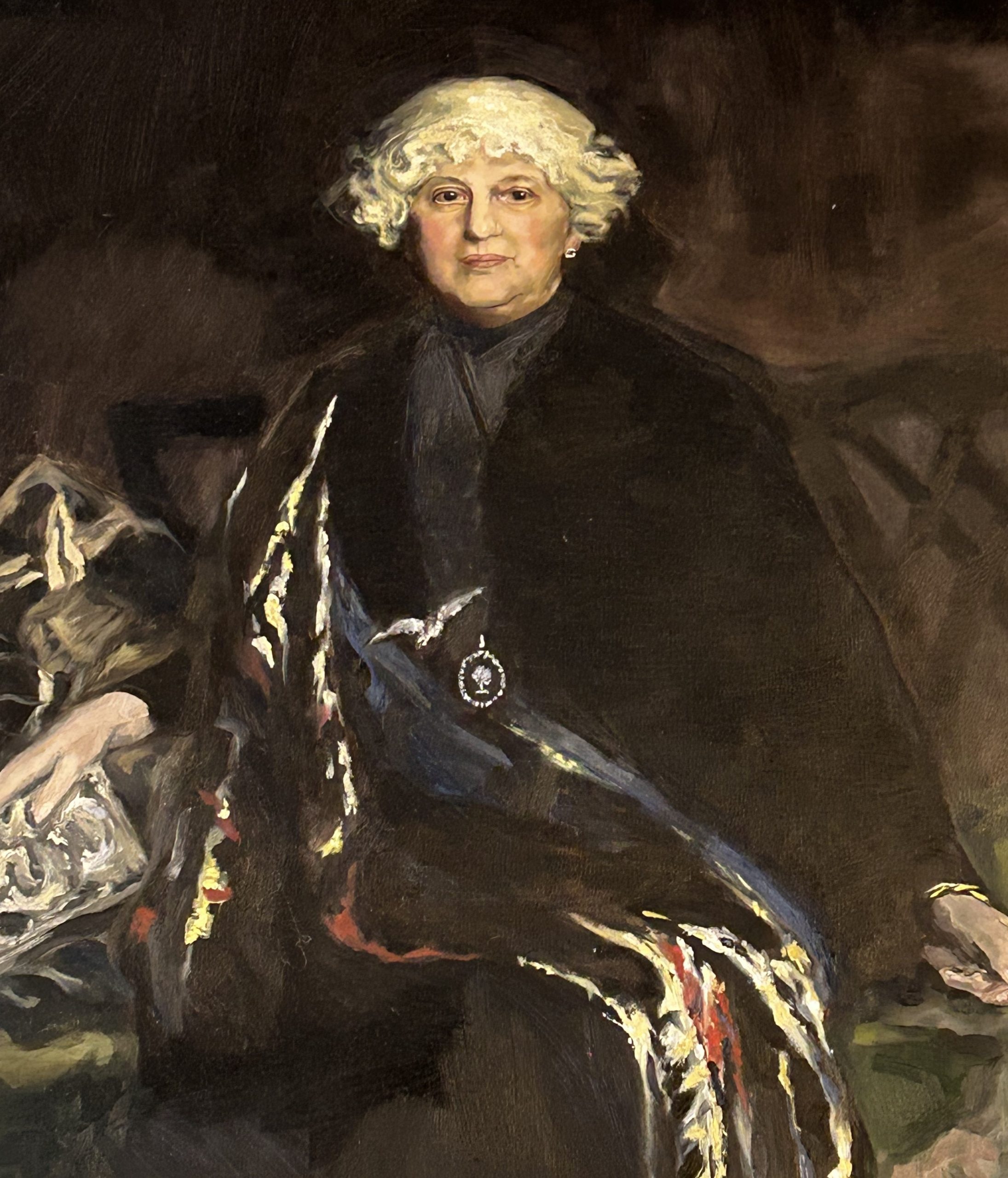
Julia Warde Aldam (1857-1931)
Painted in 2019 by Alice Channon, St Chad’s College Student 2018 – 2021, after a painting at Hooton Pagnell Hall.
Sarah Julia Warde, one of the major founding benefactors of St Chad’s, was born in 1857. Her father, William, had been a vicar but by the time Julia was born, he had retired from parish ministry, and had inherited ownership of the Hooton Pagnell estate, near Doncaster. He died in 1868 when Julia was only 11. Julia’s older sister Mary, had been born with physical and mental disabilities and because of this, Julia and Mary jointly inherited Hooton Pagnell from their father. She married William Aldam of the neighbouring Frickley estate and they combined their names to become Mr and Mrs Warde Aldam, though Julia chose to continue to live on at Hooton Pagnell even after her marriage and to devote her energies to its community.
Throughout her life, Julia used her time and money to support good causes, including a colliery brass band, local hospitals and children’s homes, schools and the church. She assisted in the design of changes to the parish church as it underwent alterations between 1885 and 1886, installed a new carillon of bells in the tower in 1895, provided candlesticks, crucifix, processional cross and lectern, paid for a new east window, provided a lych-gate and land for an extension of its burial ground.
When the local vicar, Frederick Willoughby, brought to her the idea of providing a training scheme for men who had vocations to the priesthood but whose families could not afford to pay for their education, she was sympathetic. This was the beginning of St Chad’s - in the Hooton Pagnell vicarage at the turn of the century and then formed officially in the village in 1902, with a purpose-built hostel, paid for by Julia, opening in 1903.
Her interest in the life of the community of St Chad’s extended to all aspects of its life and she continued to be involved in the minutiae of its daily social life until the final closure of the Hostel in 1921. She provided generously for its smallest needs, from a piano for its regular musical evenings to a tennis court and small sports awards.
Other rich philanthropists were attracted to the Willoughby-Warde-Aldam scheme. Chief among them was a Liverpool stockbroker, Howard Douglas Horsfall, who enabled St Chad’s to set up in Durham in 1904 and who was a generous benefactor over many years. Julia, however, remained devoted to her realm in Hooton Pagnell, and did not get involved in the Durham project – although she remained interested and supportive. She continued to focus on St Chad’s Hostel until her life’s calling was abruptly changed, as so many lives were, by the outbreak of the First World War. With the increasing stream of casualties coming back from the Front, Julia turned her stately home into a hospital, and she turned her attention to nursing shattered bodies and minds back to health. The Hostel ceased to operate as a home to St Chad’s students and although it reopened briefly after the war ended, it was eventually closed completely in 1921.
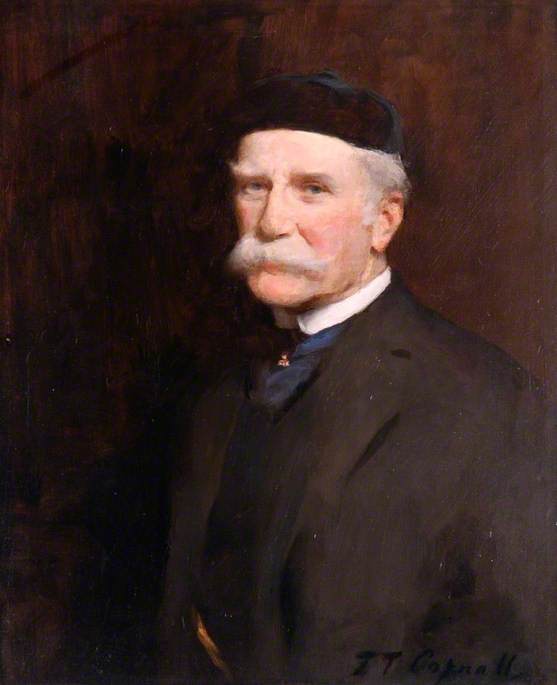
Douglas Horsfall (1856-1936)
Painted by F.T. Copnall: oil on canvas.
Howard Douglas Horsfall was born in Huddersfield in 1856. He was a wealthy Liverpool stockbroker whose generous philanthropy enabled the founding and establishment of St Chad’s College at Durham University in 1904 by providing most of the funding. He not only provided bursaries and scholarships for a significant number of the students, and contributed to the salaries of the fellows, he also very likely contributed to the College’s ability to purchase the freehold of the house at Number 1 South Bailey that was the College’s first home. Although there were other donors, it is clear that without Douglas Horsfall’s money and commitment to the vision of St Chad’s as a place where young men of Anglo-Catholic persuasion with limited financial support could train for the Anglican priesthood, the St Chad’s of today would not exist.
St Chad’s was not the only focus of Douglas Horsfall’s philanthropy. He also built and funded a number of churches in Liverpool including St Agnes & St Pancras, Toxteth Park, St Faith, Great Crosby and St Paul, Stoneycroft. The benefices of these churches passed to St Chad’s for the benefit of the College.
In the wake of the Black Lives Matter movement of summer 2020, St Chad’s, along with many institutions, began to look more carefully into the provenance of its inheritance and our late colleague, Mark Roberts, undertook some research into the Horsfall family. Although there is nothing to suggest that the money Douglas Horsfall himself made in his own right was illegitimate, the wealth he inherited from his father Robert and grandfather Charles Horsfall, is more problematic. Charles was a slave owner as is evidenced by the compensation he was awarded by the UK Government Act of 1837 for the 440 slaves he owned at the time of the abolition of slavery in 1833. The amount was £11,700, in today’s money, somewhere between £800,000 and £1m. Charles also married into the Berry family and his son Robert will have inherited some of the assets of Thomas Berry, a plantation and slave owner.
After the 1807 Abolition of Slave Trade Act, Charles Horsfall turned his focus to the palm oil business, was hugely successful in this and eventually went into partnership with John Tobin, whose family was involved in the transportation of slaves and who were vocal defenders of the Slave Trade. The palm oil business was, after the Abolition Act, seen as a legitimate trade, but when pursued in parts of Africa that were not part of the British Empire and therefore not subject to the Abolition Act, slave labour was very likely to have been used in its production.
In the light of this emerging research, St Chad’s undertook a series of discussions over the course of 2022 / 2023 to decide how we, as a College, should respond to our emerging understanding of Horsfall’s legacy. These College Conversations took place in our SCR and included students, staff, and governors and included historical context offered by academics in the University with relevant expertise. In the course of these conversations, there was considerable debate about whether or not to display Douglas Horsfall’s painting in the Moulsdale Hall and although a variety of view were expressed, the overall consensus was that we should retain this portrait: to take it down would be a kind of erasure of our history whereas we want to continue to engage with and reflect on it. We also acknowledged that neither Douglas Horsfall nor his father, Robert, was directly engaged with the trade or exploitation of enslaved people, and that Douglas, in particular, seems to have been very keen to use his wealth generously in a series of philanthropic causes of which St Chad’s was a major beneficiary.
However, there was a strong agreement that the artworks in Moulsdale Hall should be reordered and augmented to ensure that they reflect more adequately our values and aspirations as a college community. At our governors’ meeting in March 2023, governors agreed with this view and also agreed to change the name of the Horsfall Room in Ramsey House, renaming it the Ann Loades Room. They renewed our commitment to anti-racism education, and to encouraging reflection on issues around modern slavery. Governors also reiterated our longstanding commitment, in line with our founding values, to ensure that a St Chad’s education is open to all who have the qualifications and motivation to benefit, regardless their financial status. To this end, we would like to enhance our existing programme of scholarships.
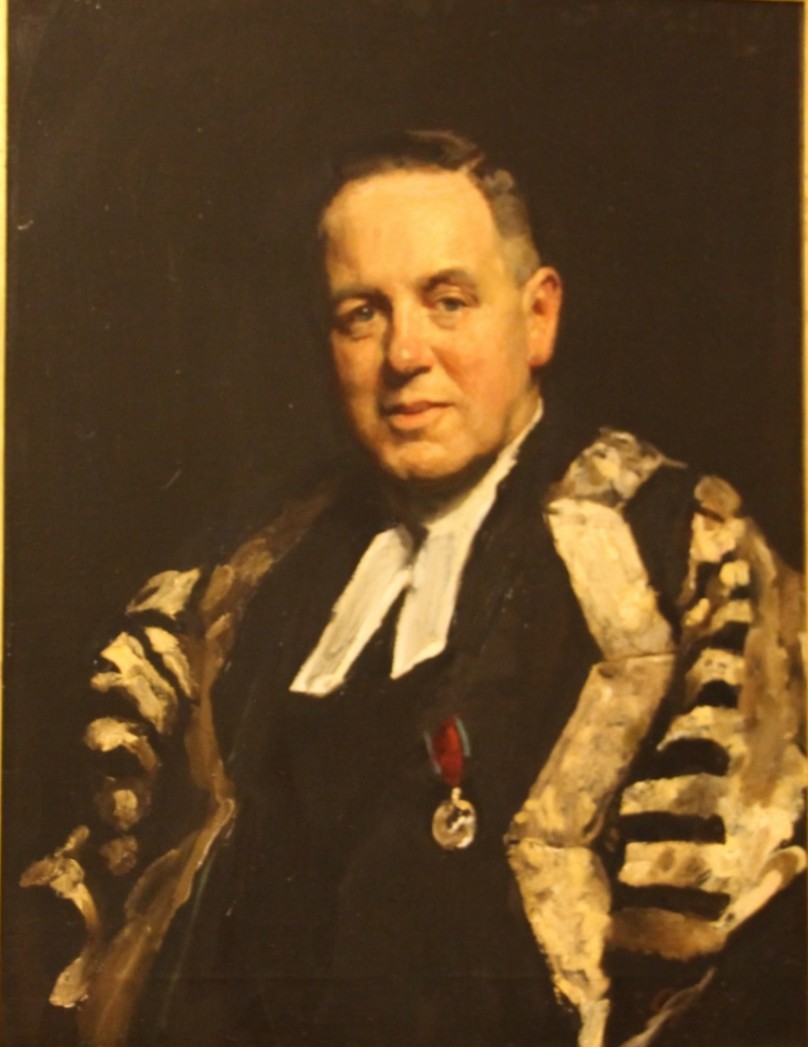
Stephen Moulsdale (1872-1944)
Oil painting on canvas by Frank Thomas Copnell.
Stephen Richard Platt Moulsdale was the first Principal of St Chad’s College between 1904-1936 and was an Anglo-Irish cleric. Born in County Sligo he was educated there and at St Aidan’s Theological College, Birkenhead before becoming curate of St Chad’s Everton. He took his MA in Divinity at Durham University in 1903. Induced by Douglas Horsfall to take up the position as Vice-Principal of St Chad’s Hostel in Hooton Pagnell in 1903 he became Principal there almost immediately on the resignation of its founder and originator, Frederick Willoughby, vicar at Hooton Pagnell. Together with his Vice-Principal, Bernard Wilson, he devised a scheme to allow for the students at the Hostel to receive a university education before proceeding to theological college. With money and accommodation provided by Douglas Horsfall, St Chad’s Hall was established in Durham and he became its first Principal. The college opened with just 19 students.
Moulsdale loved the college and was passionate about developing it. He was particularly passionate about the chapel. His wish for St Chad’s was that it should be seen as a Christian home rather than just a college. During his time as Principal, Chad’s was first and foremost a college for training Anglican clergy of the Church of England and then a college for Durham University students.
Within the university he lectured students of the Theology Department in Liturgiology. Moulsdale also took an active role within the University hierarchy. He became Junior Proctor from 1911-13, Senior Proctor in 1913-14, Secretary of the Council of the Durham Colleges from 1915-1919, Dean of the Faculty of Arts in 1921, Pro-Vice Chancellor 1932-33 and 1936-37 and Vice-Chancellor from 1934 to 1936. Within the wider Durham community, he was examining Chaplain to the Bishop of Durham from 1920 to 1936, a Proctor in Convocation and acted as a Justice of the Peace for the City of Durham.
During Moulsdale’s time as Principal, St Chad’s acquired its first purpose-built chapel (which was replaced in 1927 by our present chapel), and its first boathouse. Accommodated initially in premises at 1 South Bailey, under Moulsdale’s directorship St Chad’s successively acquired new buildings at 28 North Bailey, 15 and 17 North Bailey (houses than that were to become part of Main College) and a number of other temporary premises in the vicinity.
He guided St Chad’s through the loss of almost all its students during the First World War, its post-war rebuilding and its resulting pecuniary poverty until, with the financial guidance and support of Douglas Horsfall until the 1930s, it was firmly established and flourishing.
Although a man of enormous energy and drive, ill-health eventually forced him to retire in 1936 and he took up the college living at Hintlesham in Suffolk, where he died in 1944.
As the first Principal of St Chad’s, Moulsdale made a lasting contribution to the college and its life, and in honour of this, the dining room – added in 1961 - was named ‘Moulsdale Hall’.
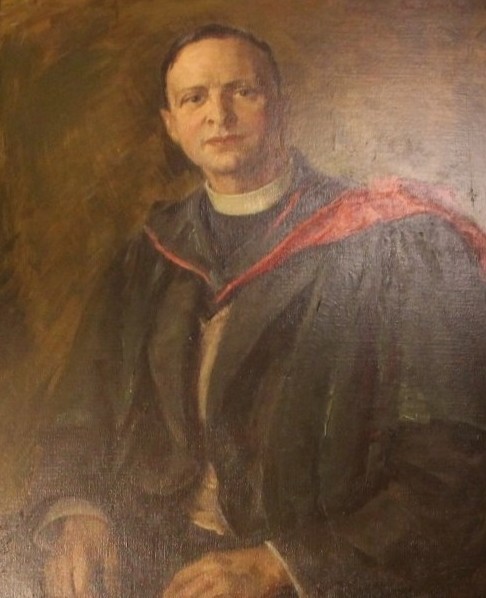
John Brewis (1902-1972)
Oil painting in canvas by T. W. Pattinson, 1948.
John Salusbury Brewis was an Anglian priest and became Principal of St Chads College after Stephen Moulsdale, from 1937-1947. Brewis went to Eton and studied Modern History at Hertford College, Oxford. He then worked for a year at Princeton University before returning to Cuddesdon, Oxfordshire. After spending a couple of years as an Assistant Master at Eton he went on to become Vice-Principal and Tutor at St Edmund’s Hall, Oxford. He was ordained in 1927.
At St Chad’s he found a college in need of expansion. A scheme for new buildings launched in 1938 had to be shelved on the outbreak of World War II but it was never abandoned. Several sets of plans were drawn up to establish St Chad’s and to consolidate its building stock on a single site in its now present location. Brewis found himself instead constrained to preserve the college’s financial resources during a difficult period, when the student roll dropped as low as only 13 students, even fewer than during World War I. He nevertheless kept St Chad’s afloat throughout the war and through post-war rationing.
The prayer life of the chapel was at the heart of his vision for St Chad’s. He was also instrumental in setting in motion attempts to secure St Mary le Bow (the church between St Chad’s and Hatfield College, currently Durham Heritage Museum) as a replacement college chapel, ultimately unsuccessful. He did, however, successfully reorganise the college library, re-arranging the stock and cataloguing it.
After retiring in 1947 he became successively Vicar of St James, Melton-on-the-Hill & Rural Dean of Doncaster, and Rector of St James Piccadilly. He also became an ex-officio member of the York Convocation, contributing to the system of Synodical Government initiated in 1952 which provided a greater role for lay contribution. He died in 1972.
Brewis played a significant role in maintaining the college during the Second World War and Post-War Depression. Brewis used college funding saved by its trustees to maintain the college and continue supporting students who did not have the funds to attend the university, particularly welcoming returning servicemen and enabling the resultant mix of ages and experiences within the student body to create a healthy community. Brewis had a formidable academic background. With it he developed a view of the potential of education for the lives of those who came to St Chad’s. At the heart of this was his conviction that Christian ethics lay at the heart of action. He was described at his funeral as “Shy, wise and godly”.
One of the loveliest college library rooms is named the Brewis Library in his honour.
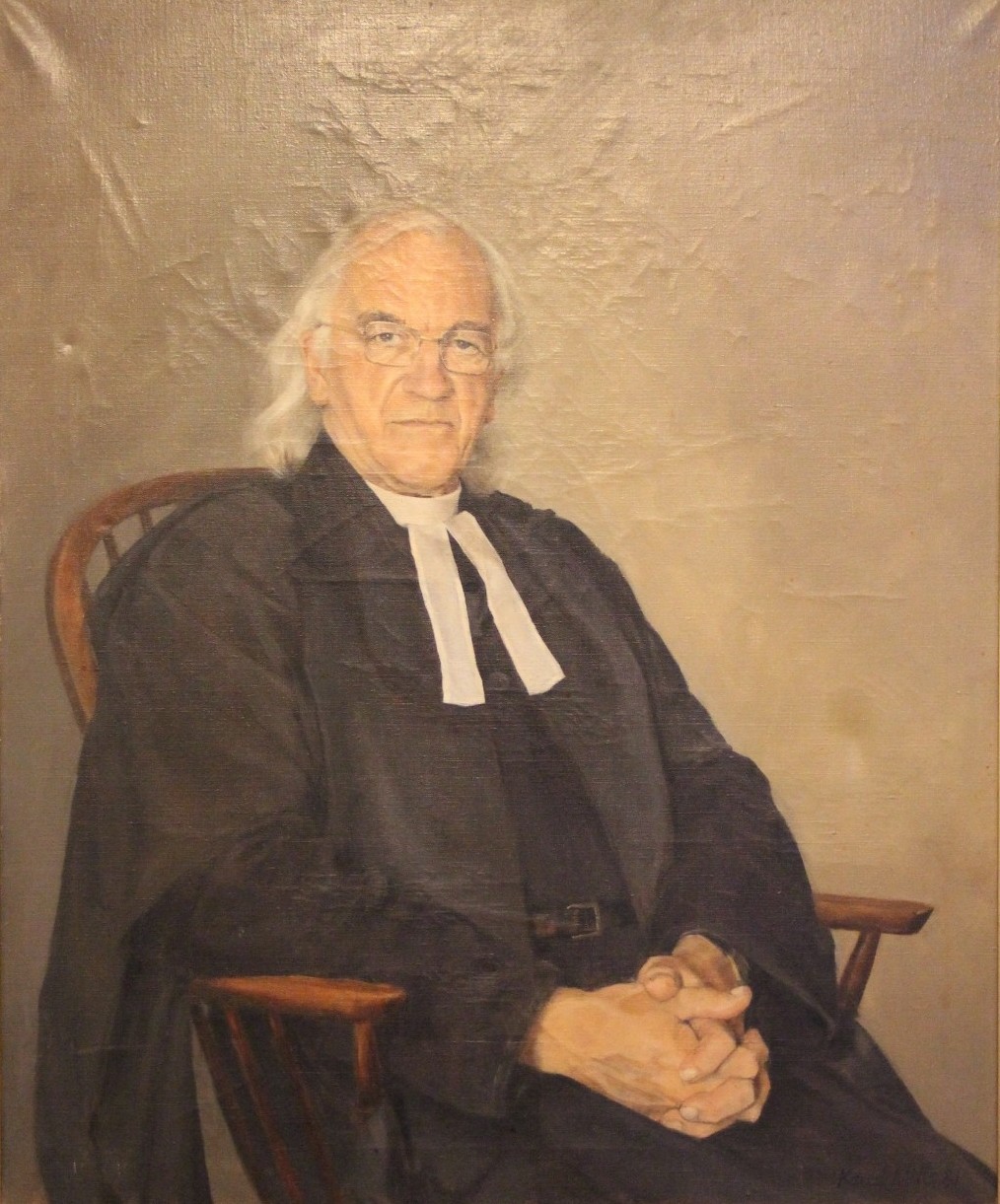
John Fenton (1921-2008)
Oil painting on canvas of John Fenton by Karen Mills, 1981.
John Charles Fenton was a priest of the Church of England and an eminent scholar of the New Testament. The son of a Liverpool cleric, Fenton graduated from St Peter’s Hall, Oxford, where he became influenced by the theology of Soren Kierkegaard. He trained for ordination at Queen’s College, Birmingham. After a brief Curacy at All Saints, Hindley, Liverpool he became successively Chaplain and Sub-Warden at Lincoln Theological College, where he became a noted New Testament scholar and wrote a number of books on biblical criticism, before becoming its Principal from 1954 to 1965.
Fenton served as Principal of St Chad’s College between 1965-1978. The St Chad’s he inherited in the 1960s was a thriving institution consolidated on the site we know as 18 North Bailey. Its finances were then sound but inflation during the 1970s presented severe problems for survival, solved in part by increasing the size of the student body. Under him the number of students rose from just 70 to 170 men. Plans to acquire and use St Mary le Bow had also to be shelved in favour of the renovation and re-ordering of the chapel. The first purpose-designed college bar was established in the basement with its distinctive mural and decoration.
Fenton came to St Chad’s at a time of major social change with rising student unrest nationally and young people less willing to accept externally imposed discipline. The life of the chapel was also responding to external changes by shifting from an old-fashioned Anglo-Catholicism to offer a wider range of theological views and tastes. It was also a time when teaching by college staff in theology, classics and history came to an end and the staff team was reduced to just two - the Principal and Vice-Principal – who were employed as full-time academics.
John Fenton guided St Chad’s through major transition when its purpose changed from taking its students through preparation for ministry to its redefinition as an independent academic institution within the wider Durham University - whilst still successfully retaining its distinctive Anglican ethos. It was during this time that the College ceased training ordinands for ministry in the Church of England, and it was John Fenton who laid the foundation for the College as we know it today.
John Fenton left St Chad’s on the eve of its 75th anniversary celebrations to become a Residentiary Canon at Christ Church, Oxford. He retired there in 1991 and died in 2008.
Fenton’s was a larger-than-life personality. He loved to debate and often took others by surprise by his stance on certain issues. His intellectual honesty and notable biblical scholarship were combined with immense kindness to generations of students, and he is also remembered for his wicked sense of humour and deep spirituality.
Among its seven libraries, St Chad’s named the Fenton library in his honour.
